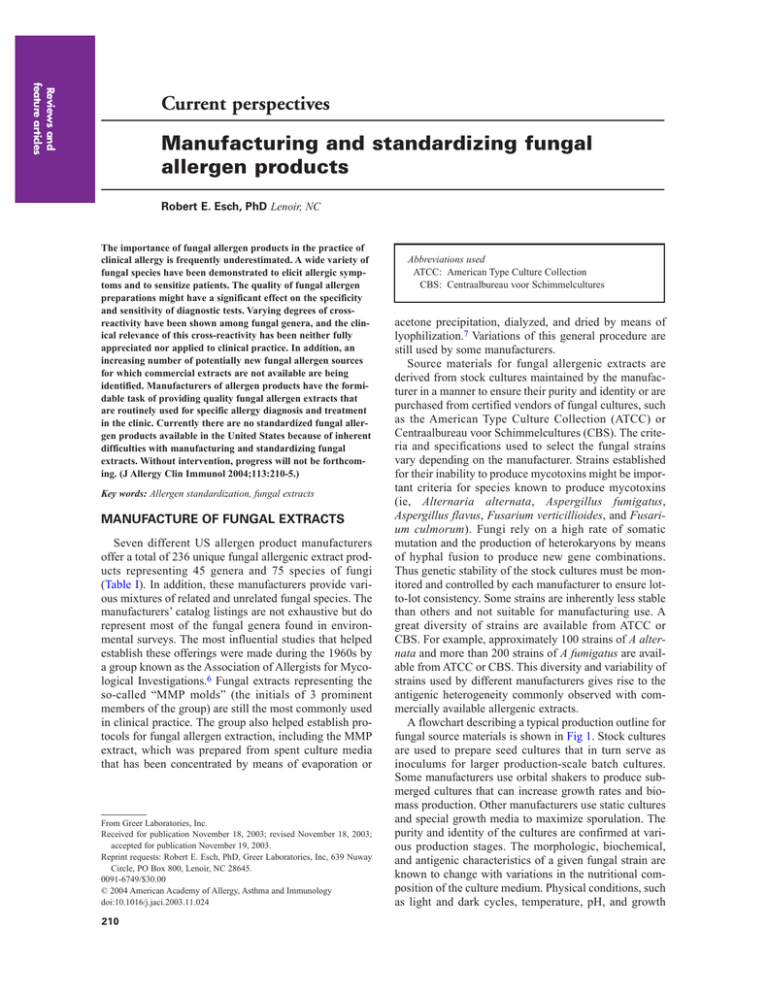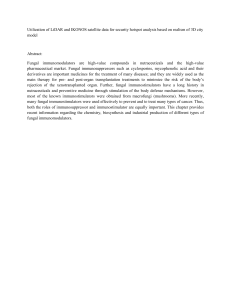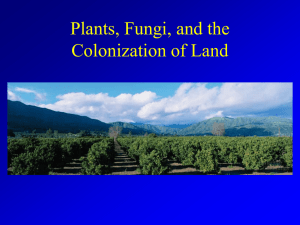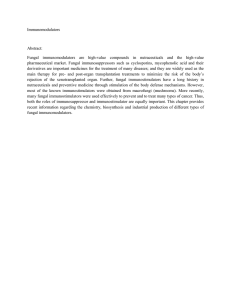Manufacturing and Standardizing Fungal Allergen Products
advertisement

Reviews and feature articles Current perspectives Manufacturing and standardizing fungal allergen products Robert E. Esch, PhD Lenoir, NC The importance of fungal allergen products in the practice of clinical allergy is frequently underestimated. A wide variety of fungal species have been demonstrated to elicit allergic symptoms and to sensitize patients. The quality of fungal allergen preparations might have a significant effect on the specificity and sensitivity of diagnostic tests. Varying degrees of crossreactivity have been shown among fungal genera, and the clinical relevance of this cross-reactivity has been neither fully appreciated nor applied to clinical practice. In addition, an increasing number of potentially new fungal allergen sources for which commercial extracts are not available are being identified. Manufacturers of allergen products have the formidable task of providing quality fungal allergen extracts that are routinely used for specific allergy diagnosis and treatment in the clinic. Currently there are no standardized fungal allergen products available in the United States because of inherent difficulties with manufacturing and standardizing fungal extracts. Without intervention, progress will not be forthcoming. (J Allergy Clin Immunol 2004;113:210-5.) Key words: Allergen standardization, fungal extracts MANUFACTURE OF FUNGAL EXTRACTS Seven different US allergen product manufacturers offer a total of 236 unique fungal allergenic extract products representing 45 genera and 75 species of fungi (Table I). In addition, these manufacturers provide various mixtures of related and unrelated fungal species. The manufacturers’ catalog listings are not exhaustive but do represent most of the fungal genera found in environmental surveys. The most influential studies that helped establish these offerings were made during the 1960s by a group known as the Association of Allergists for Mycological Investigations.6 Fungal extracts representing the so-called “MMP molds” (the initials of 3 prominent members of the group) are still the most commonly used in clinical practice. The group also helped establish protocols for fungal allergen extraction, including the MMP extract, which was prepared from spent culture media that has been concentrated by means of evaporation or From Greer Laboratories, Inc. Received for publication November 18, 2003; revised November 18, 2003; accepted for publication November 19, 2003. Reprint requests: Robert E. Esch, PhD, Greer Laboratories, Inc, 639 Nuway Circle, PO Box 800, Lenoir, NC 28645. 0091-6749/$30.00 © 2004 American Academy of Allergy, Asthma and Immunology doi:10.1016/j.jaci.2003.11.024 210 Abbreviations used ATCC: American Type Culture Collection CBS: Centraalbureau voor Schimmelcultures acetone precipitation, dialyzed, and dried by means of lyophilization.7 Variations of this general procedure are still used by some manufacturers. Source materials for fungal allergenic extracts are derived from stock cultures maintained by the manufacturer in a manner to ensure their purity and identity or are purchased from certified vendors of fungal cultures, such as the American Type Culture Collection (ATCC) or Centraalbureau voor Schimmelcultures (CBS). The criteria and specifications used to select the fungal strains vary depending on the manufacturer. Strains established for their inability to produce mycotoxins might be important criteria for species known to produce mycotoxins (ie, Alternaria alternata, Aspergillus fumigatus, Aspergillus flavus, Fusarium verticillioides, and Fusarium culmorum). Fungi rely on a high rate of somatic mutation and the production of heterokaryons by means of hyphal fusion to produce new gene combinations. Thus genetic stability of the stock cultures must be monitored and controlled by each manufacturer to ensure lotto-lot consistency. Some strains are inherently less stable than others and not suitable for manufacturing use. A great diversity of strains are available from ATCC or CBS. For example, approximately 100 strains of A alternata and more than 200 strains of A fumigatus are available from ATCC or CBS. This diversity and variability of strains used by different manufacturers gives rise to the antigenic heterogeneity commonly observed with commercially available allergenic extracts. A flowchart describing a typical production outline for fungal source materials is shown in Fig 1. Stock cultures are used to prepare seed cultures that in turn serve as inoculums for larger production-scale batch cultures. Some manufacturers use orbital shakers to produce submerged cultures that can increase growth rates and biomass production. Other manufacturers use static cultures and special growth media to maximize sporulation. The purity and identity of the cultures are confirmed at various production stages. The morphologic, biochemical, and antigenic characteristics of a given fungal strain are known to change with variations in the nutritional composition of the culture medium. Physical conditions, such as light and dark cycles, temperature, pH, and growth Esch 211 Reviews and feature articles J ALLERGY CLIN IMMUNOL VOLUME 113, NUMBER 2 FIG 1. Production outline for fungal source materials. See text for details. QC, Quality control. period, might be important for sporulation and might affect allergen production. Because no 2 manufacturers use the same culture medium or culture conditions, qualitative differences between products manufactured by different companies are expected, even when identical strains of fungal stock cultures are used. Allergenic materials produced by fungi during cultivation are distributed throughout the culture in the form of spores, mycelia, and extracellular components secreted into the growth medium.8-11 Manufacturers might retain the cellular (spores and mycelia), the extracellular (culture filtrate), or the whole culture during harvest. If culture filtrates are retained, nonantigenic culture media are used. If spores are retained, then they are rendered nonviable through chemical or physical means before transfer to the manufacturing (extraction) facilities. Various processing steps, including centrifugation, filtration, diafiltration, acetone precipitation, and lyophilization, are used to recover the allergenic materials from fungal cultures. Each manufacturer’s process requirements and specifications are unique and defined as part of their product and establishment licenses. Fig 2 presents a typical production outline for fungal allergenic extracts. Fungal source materials are reconstituted from the lyophilized state or extracted in an appropriate buffer to recover the soluble allergenic materials. The allergenic potency of extracts can be influenced by a number of variables in the extraction procedure. The most important extraction parameters include the extraction buffer, pH, ratio, time, and temperature. The most common extraction buffer used by US manufacturers is Coca’s extraction buffer, a slightly alkaline carbonate buffer developed to maximize protein recovery from allergen source materials. Manufacturers might add glycerin or phenol as preservatives. Extraction ratios are expressed as weight/volume or the weight in grams of the source material extracted to the volume in milliliters of extraction fluid. For example, a 1:10 wt/vol on a label designates an extract that was prepared with 1 g of source material for every 10 mL of extraction fluid. Some aller- 212 Esch J ALLERGY CLIN IMMUNOL FEBRUARY 2004 Reviews and feature articles TABLE I. Commercially available fungal allergen extracts Species Synonym Species Acremonium stricturm Alternaria alternata Apiospora montagnei Aspergillus fumigatus Aspergillus niger Aspergillus glaucus Aspergillus terreus Aspergillus nidulans Aspergillus flavus Aureobasidium pullulans Botrytis cinerea Candida albicans Candida tropicalis Chaetomium globosum Cladosporium herbarum Cladosporium sphaerospermum Cladosporium cladosporoides Cephalosporium acrenomium Alternaria tenuis Papularia Neurospora intermedia Nigrospora oryzae Nigrospora sphaerica Paecilomyces variotii Paecilomyces clavisporis Penicillium notatum Penicillium chrysogenum Penicillium digitatum Phoma betae Phoma herbarum Phoma destructive Phycomyces blakesleenus Pleospora herbarum Rhizopus oryzae Rhizopus stolonifer Rhodotorula mucilagnosa Saccharomyces cerevisiae Scopulariopsis brevicaulis Sporotrichum pruinosum Stachybotrys chartarum Stemphylium botryosum Stemphylium solani Stemphylium sarcinaeforme Streptomyces griseus Syncephalastrum racemosum Tetracoccosporium paxianum Trichoderma harzianum Trichophyton mentagrophytes Trichophyton rubrum Trichophyton tonsurans Trichothecium roseum Verticillium albo-atrum Puccinia graminis tritici Ustilago maydis Ustilago cynodontis Ustilago nuda Ustilago avenae Ustilago tritici Sphacelotheca cruenta Colletotrichum atramentarium Curvularia lunata Drechslera specifera Epicoccum nigrum Epidermophyton floccosum Fusarium solani Fusarium moniliforme Fusarium vasinfectum Geotrichum candidum Gliocladium viride Gliocladium fimbriatum Helminthosporium sativum Helminthosporium solani Hypocrea rufa Microsporum canis Mucor circinelloides (formerly lusitanicus) Mucor circinelloides (formerly circinelloides) Mucor plumbeus Mycogone perniciosa Pullularia pullulans Hormodendrum hordei Hormodendrum cladosporoides Spondylocladium atramentarium Curvularia specifera Epicoccum purpurascens Fusarium oxysporum Gliocladium deliquescens Spondylocladium atrovirens Mucor racemosus Mucor mucedo gens are rapidly eluted from fungal source materials, whereas others might require homogenization, shaking, or long extraction times for maximum recovery. There exists a tradeoff between maximum allergen recovery and the increased release of nonallergenic substances and proteases, which might degrade some allergens. Many different procedures have been devised to extract allergens from fungi, and no single process has been universally adopted by the industry.12 The extract is clarified by means of centrifugation, filtration, or both through a series of filters of decreasing porosity. The supernatant or filtrate might undergo further processing, such as dialysis to remove low-molecular-weight nonallergenic material and the addition of glycerin. The extract is rendered sterile by passing the extract through a sterilizing filter with a 0.2-µm porosity. The clarifying and sterilizing filters used must be shown not to adsorb allergens onto their surface and not to contribute any residual material into the product. The sterile extract is quarantined until tested and released for additional aseptic processing. Quality control testing of Synonym Monilia sitophila Stemphylium herbarum Rhizopus arrhizus Rhizopus nigricans Rhodotorula rubra Penicillium brevicaulis Chrysosporium pruinosum Trichoderma lignorum Cephalothecium roseum Sporisorium cruenta this sterile intermediate or bulk extract include tests for sterility, safety (toxicity in animals), pH, protein nitrogen units, and preservative (phenol or glycerin). The released bulk extract is aseptically diluted, mixed with other bulk products, or used without further processing to prepare stock concentrates, custom mixtures, or individual prescriptions for sale. COMPOSITION OF FUNGAL ALLERGENIC EXTRACTS Fungal allergenic extracts are complex mixtures of proteins, glycoproteins, polysaccharides, and other substances. The mean protein and carbohydrate concentrations of selected fungal stock concentrates prepared by a single manufacturer at 1:10 wt/vol are presented in Table II. At equivalent weight/volume concentrations, the protein content varied approximately 7-fold. All extracts tested contained significantly higher concentrations of carbohydrate compared with protein, with the ratio ranging from about 5 to 25. Esch 213 Reviews and feature articles J ALLERGY CLIN IMMUNOL VOLUME 113, NUMBER 2 FIG 2. Production outline for fungal allergenic extracts. See text for details. QC, Quality control. TABLE II. Protein and carbohydrate content of various fungal allergen products Fungal species Alternaria alternata Helminthosporium sativum Penicillium notatum Aspergillus fumigatus Cladosporium cladosporoides Ustilago maydis Protein (mg/mL) 0.73 0.44 0.38 0.28 0.25 0.10 The protein, carbohydrate, and Alt a 1 contents and the relative potencies of A alternata products manufactured by different companies are shown in Table III. When adjusted to equivalent weight/volume concentrations, the protein and carbohydrate contents varied by more than Carbohydrate (mg/mL) 4.27 2.56 3.58 4.16 6.00 2.38 Ratio 6 5 9 15 24 24 100-fold. Similar variations in the protein and carbohydrate contents of commercially available fungal extracts derived from Penicillium notatum, A fumigatus, Epicoccum nigrum, Helminthosporium sativum, and Aureobasium pullulans were found (data not shown). The variabili- 214 Esch J ALLERGY CLIN IMMUNOL FEBRUARY 2004 Reviews and feature articles FIG 3. SDS-PAGE profiles of commercial A alternata extracts: lane 1, molecular weight standards; lane 2, 1:10 wt/vol Greer aqueous; lane 3, 1:20 wt/vol Greer glycerinated; lane 4, 1:10 wt/vol Hollister-Stier aqueous; lane 5, 1:10 wt/vol Hollister-Stier glycerinated; lane 6, 1:20 wt/vol Allergy Labs glycerinated; lane 7, 1:10 wt/vol ALK glycerinated; lane 8, 1:10 wt/vol Allermed glycerinated; lane 9, 1:10 wt/vol Nelco glycerinated; lane 10, 1:10 wt/vol Antigen Labs glycerinated. Samples were loaded at 0.7 µg of protein except for lanes 6 and 9, which were loaded at 0.3 µg and 0.2 µg, respectively, because of low protein content of the extracts. Components were visualized by means of silver staining. TABLE III. Composition of Alternaria alternata products from different manufacturers Manufacturer Wt/vol Protein (mg/mL) Carbohydrate (mg/mL) Alt a 1 (µg/mL) Relative potency Greer Hollister-Stier ALK-Abello Allergy Labs Allermed Nelco Labs Antigen Labs 1:10 1:10 1:10 1:20 1:10 1:5 1:10 0.73 0.19 0.03 0.06 0.15 0.08 0.15 4.27 11.38 17.14 31.30 2.40 33.79 10.96 1.85 2.75 0.04 0.05 0.05 2.04 0.09 1.334 0.246 0.281 0.061 0.581 0.012 0.219 ty in specific allergen content and ELISA inhibition potency of A alternata extracts from different manufacturers was consistent with that found in previous reports.13,14 No significant correlation (r < .5) was observed between the Alt 1 concentrations and the respective protein, carbohydrate, and relative potency values. The compositional profiles evaluated by means of SDS-PAGE of various A alternata products manufactured by different companies are presented in Fig 3. No two company’s products yielded comparable banding patterns. Similar profiles were evident between aqueous and glycerinated products manufactured by one company (lanes 2 and 3). In contrast, significant differences were evident between aqueous and glycerinated products manufactured by another company (lanes 4 and 5). On the basis of compositional analyses, it becomes obvious that the different manufacturers’ products are qualitatively different and that weight/volume designations do not reflect the relative antigen or allergenic activities of fungal allergen products. Such differences in the composition of fungal allergen products from the same fungal species with identical weight/volume designations raise questions regarding their interchangeability. Fungal allergen extracts are known to contain proteolytic activity that can reduce the allergenicity of other extracts when combined in therapeutic allergen vaccines.15-17 Grass pollen extracts appear to be most susceptible to degradation, whereas others, such as short ragweed pollen extracts, are quite resistant. Increasing the glycerin concentration in the vaccines reduces the deleterious effect, but it has been recommended that fungal extracts be formulated in separate vials to maximize vaccine stability.18 STANDARDIZATION OF FUNGAL ALLERGEN VACCINES A goal of standardization is to ensure the lot-to-lot consistency of allergen products. Within the limitations imposed by each manufacturer’s product licenses, this might be achievable for final products manufactured by a given company. Strict adherence to established manu- facturing and quality controls for monitoring consistency can reduce product variability.19 However, if standardization is to ensure consistency among products marketed by different manufacturers, then this goal does not appear possible for fungal allergen products. The marked differences in source materials and manufacturing procedures used, the lack of generally accepted potency assays, and the great variety of potentially allergenic fungal species have impeded any significant progress in fungal allergen standardization. Novel fungal standardization approaches have been suggested in the past, including the pooling of selected relevant strains to ensure an adequate complexity in composition.10,20 This approach requires knowledge of most or all relevant allergens and the development of new quality control procedures. The establishment of a wellcharacterized reference preparation with a validated potency assay could facilitate allergen standardization efforts. In the 1980s, an international collaborative group developed a reference standard of A alternata under the auspices of the World Health Organization/International Union of Immunological Societies allergen standardization committee.21 This initiative failed to gain wide acceptance by manufacturers, regulatory authorities, clinicians, and research laboratories. In 1997, the American Academy of Allergy, Asthma and Immunology Allergen Standardization Committee included Alternaria, Cladosporium, Penicillium, and Aspergillus species as priorities for allergen standardization efforts.22 There have been no new initiatives after the publication of this position statement. CONCLUSIONS Fungal allergen extracts produced by the different US manufacturers are highly variable in composition and should not be considered interchangeable. If one accepts this conclusion, then the total number of unique fungal allergen products marketed in the United States today exceeds 200. Standardization of fungal extracts or vaccines has been and will continue to be difficult because manufacturers use distinctly different strains, cultivation and source material processing methods, extraction processes, and quality control procedures. In contrast to other allergen sources, such as Hymenoptera venoms, pollens, dust mites, and cat dander, the limited knowledge of relevant allergens and the lack of generally accepted reference reagents and validated potency assays has impeded progress in developing a viable approach for standardizing fungal vaccines. Improvement in the safety, efficacy, and accuracy of fungal allergy diagnosis and immunotherapy will not be achieved without a coordinated effort by manufacturers, regulatory authorities, clinicians, and researchers. I thank Stewart Nielsen (Allermed), Shirley Williamson (Hollister-Stier), Peter Hauck (ALK-Abello), Fabio Cipolla (Nelco), Richard Bishop (Allergy Laboratories), Tom Willoughby (Antigen Labs), and Tom Grier (Greer Laboratories) for helpful discussions. I also thank Dawn Hazelhurst and Elizabeth Duncan (Greer Laboratories) for their technical expertise in performing the analytic tests. REFERENCES 1. Aas K, Leegaard J, Aukrust L, Grimmer O. Immediate type hypersensitivity to common moulds. Allergy 1980;33:443-51. 2. Weber RW. Cross-reactivity of plant and animal allergens. Clin Rev Allergy Immunol 2001;21:153-202. 3. Vijay HM, Thaker AJ, Banerjee B, Kurup VP. Mold allergens. In: Lockey RF, Bukantz SC, editors. Allergens and allergen immunotherapy. 2nd ed. New York: Marcel Dekker, Inc; 1999. p. 133-54. 4. Horner WE, Helbling A, Salvaggio JE, Lehrer SB. Fungal allergens. Clin Microbiol Rev 1995;8:161-79. 5. Shelton BG, Kirkland KH, Flanders WD, Morris GK. Profiles of airborne fungi in buildings and outdoor environments in the United States. Appl Environ Microbiol 2002;68:1743-53. 6. Morrow MB, Meyer GH, Prince HE. A summary of air-borne mold surveys. Ann Allergy 1964;22:575-87. 7. Prince HE, Halpin LJ, Talbett G, et al. Molds and bacteria in the etiology of respiratory allergic diseases. XXI. Studies with mold extracts produced from cultures grown in modified synthetic media. Ann Allergy 1961;19:259-67. 8. Aukrust L, Borch SM, Einarsson R. Mold allergy: spores and mycelium as allergen sources. Allergy 1985;40(suppl 3):43-8. 9. Arruda LK, Mann BJ, Chapman MD. Selective expression of a major allergen and cytotoxin, Asp f I, in Aspergillus fumigatus. J Immunol 1992;149:3354-9. 10. Portnoy J, Pacecho F, Barnes C, Upadrastita B, Crenshaw R, Esch R. Selection of representative Alternaria strain groups on the basis of morphology, enzyme profile, and allergen content. J Allergy Clin Immunol 1993;91:773-82. 11. Nissen D, Petersen LJ, Esch R, et al. IgE-sensitization to cellular and culture filtrates of fungal extracts in patients with atopic dermatitis. Ann Allergy 1998;81:247-55. 12. Hauck PR, Williamson S. The manufacture of allergenic extracts in North America. Clin Rev Allergy Immunol 2001;21:93-110. 13. Vailes L, Sridhara S, Cromwell O, Weber B, Breitenbach M, Chapman MD. Quantitation of the major fungal allergens Alt a 1 and Asp f 1, in commercial allergenic products. J Allergy Clin Immunol 2001;107:641-6. 14. Yunginger JW, Jones RT, Gleich GJ. Studies on Alternaria allergens II. Measurement of the relative potency of commercial Alternaria extracts by direct RAST and by RAST-inhibition. J Allergy Clin Immunol 1976;58:405-13. 15. Esch RE. Role of proteases on the stability of allergenic extracts. In: Kurth R, editor. Regulatory control and standardization of allergenic extracts. Stuttgart: Gustav Fischer; 1991. p. 171-9 16. Kordash TR, Amend MJ, Williamson SL, Jones JK, Plunkett GA. Effect of mixing allergenic extracts containing Helminthosporium, D. farinae, and cockroach with perennial ryegrass. Ann Allergy 1993;71:240-6. 17. Nelson HS, Ikle D, Buchmeier A. Studies of allergen extract stability: the effects of dilution and mixing. J Allergy Clin Immunol 1996;98:382-8. 18. ILi JT, Lockey RF, Bernstein IL, Portnoy JM, Nicklas A, editors. Allergen immunotherapy: a practice parameter. Joint Task Force on Practice Parameters. Ann Allergy 2003;90:1-50. 19. Wahl R, Oliver JD, Hauck PR, Winter HG, Maasch HJ. Comparison of Alternaria tenuis extracts prepared from different raw materials. Ann Allergy 1989;63:527-31. 20. Steringer I, Aukrust L, Einarsson. Variability of antigenicity and allergenicity in different strains of Alternaria alternata. Int Arch Allergy Appl Immunol 1987;84:190-7. 21. Helm RM, Squillace DL, Yuninger JW, Members of the International Collaborative Trial. Production of a proposed international reference standard Alternaria extract. II. Results of collaborative trial. J Allergy Clin Immunol 1988;81:651-63. 22. AAAAI. Position statement. The use of standardized allergen extracts. J Allergy Clin Immunol 1997;99:583-6. Reviews and feature articles Esch 215 J ALLERGY CLIN IMMUNOL VOLUME 113, NUMBER 2




